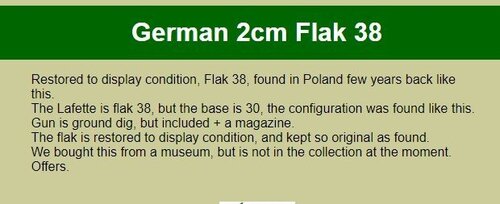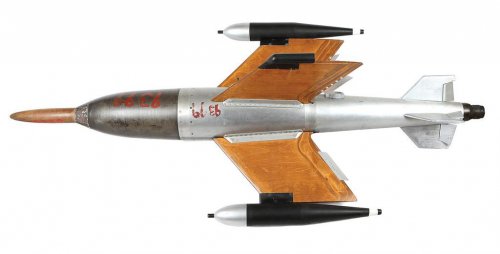
gacol
Użytkownik forum-
Zawartość
278 -
Rejestracja
-
Ostatnia wizyta
Zawartość dodana przez gacol
-
A z boku jest odcisk łapy i napis Blondie?
-
Bell P-39 Airacobra Kisielice
temat odpowiedział gacol → na Woodhaven → Marynarka, Lotnictwo i okolice
-
Jak tam?
-
Ten.
-
Śmiało, jutro 100 baniek w loterii, możecie za to sfinansować odbudowę każdego zrzyna Pantery w naszym kraju.
-
-
Jak się ma kasę, to chyba żaden kłopot odbudować. Szokiem był Tygrys I na Militracs, ale jeszcze większym szokiem informacja, że oprócz niego jest aktualnie jeszcze 6 innych "robiących się" w Niemczech.
-
Czyżby sezon ogórkowy? Mnie osobiście zaciekawiła wzmianka pod koniec filmu o 2 Panterach w Polsce, z forum pamiętam wzmianki o jednej koło Warszawy.
-
Mają immunitet od wniosku o dostęp do informacji publicznej?
-
Jedyny taki zabytek w Polsce z Muzeum Broni Pancernej w Poznaniu będzie uszkodzony. Dlaczego? (msn.com)
-
Raczej regularnością prowadzenia wojen, inwestowania w B+R, itp; wielkość kraju nie - masz przykład w końcu niemałej Rosji, a wysokością budżetu też się nie wygrywa vide Arabia S. dostająca lanie w Jemenie.
-
Tak nie do końca nie ma: na początek przeprosić się z atomem i odstąpić od dekarbonizacji. Wojna z jednym i drugim to wynik ideologii. Kiedyś za ZSRR szerokim strumieniem szły przez Finlandię $ dla ruchów pacyfistycznych w RFN, ci darli japy przeciwko Pershingom; teraz też ktoś powinien posprawdzać przelewy. Wybaczcie oftop.
-
Macie wolne kilka baniek papieru i trochę większą sadzawkę? https://www.platinumfighters.com/inventory/1945-martin-jrm-3-mars/
-
Za te to mu mogą naskoczyć - kupił/dostał/zamienił/łotewer od legalnego właściciela.
-
Luftwaffe. Ciekawostki z aukcji - część 3
temat odpowiedział gacol → na bodziu000000 → Marynarka, Lotnictwo i okolice
https://www.proxibid.com/Firearms-Military-Artifacts/Military-Artifacts/Extremely-Rare-German-Ruhrstahl-X-4-Air-to-Air-Missile/lotInformation/63281971#topoflot This is an original example of a very rare German Second World War X-4 air-to-air missile. This example is made up of original and later restored parts, the bulk of the body and all internals are original German pieces. Developed by Dr Max Kramer at Ruhrstahl AG in 1943-44, the X-4 was designed to be used against Allied bombers, just outside of the range of their defensive guns. The rocket is fin-stabilized and had a Kranich acoustical proximity fuze warhead, tuned to 200 Hz, the frequency cycle of the B-17's engines at cruise. Also spin-stabilized at about 60 rpm, the missile was guided by two wires which unwound from aerodynamic bullet-shaped fairings mounted on the main fins trailing about 3.4 miles of wire. These wires were controlled by a joystick in the cockpit the pilot would use to steer the missile toward the targeted aircraft. The warhead consisted of a 44 pound high explosive fragmentation device with a lethal radius of about 26 ft. The airframe of the X-4 consists of a cylindrical body 75'' in length and about 8 3/4'' maximum diameter on-which are mounted four large plywood fins fitted to the midsection of the missile and four small tail fins, in-which the rake spoilers are mounted. The main wing span is roughly about 23'' and steering is effected by means of rake spoilers located in the tail fins. The rocket was powered by a BMW 109-548 liquid-fuel rocket engine using a fairly dangerous mix of liquid rocket fuel giving about 310 pounds of initial thrust over a 17 second burn. Our example features an original warhead/nosecone, fuse housing, airframe-body with internal fuel coils, air canister and other internals, air bottle and BMW rocket engine and exhaust venturi nozzle. The warhead, mock proximity fuse (the fuse is made of wood and perhaps was to test aerodynamics?) and fuel body are painted in red ''9399'', the warhead also lightly engraved ''empty'' perhaps by ordnance or whomever attained the example post-war. The main fuel body is stamped ''388647'' along with a ''P'' along with ''V23'' in a small half-circle and ''BAL/592'' within an octagon, adjacent to this radially is ''109.548-JGZ'' (The model of the engine and JGZ, the ordnance code for BMW Flugmotorenbau Werk Munich, maker of the engine). The rear face of the air bottle on the interior of the missile is marked similarly with the half-circle with ''V39'' within with a capital ''R'' and capital ''SV'' stamp twice on its rear face. The plywood fins and canisters on the end of each are nicely made post-war replacements, doubtless the actual original plywood fins deteriorated years ago, as well the small electrical interface atop the body appears to be a later replacement mockup and the tail cone (covering) may be a postwar restoration as well. The first flight test of the X-4 occurred on August 11, 1944, using a Focke-Wulf Fw 190. There were subsequent tests planned for Junkers Ju 88, Messerschmitt Me 262 and DO 335 which never materialized. It is estimated about 1000 units were produced, most of these were destroyed by Allied bombing, with a small handful of these rockets in museums around the world. Included with our example are numerous photographs of the interior pieces taken by the former owner when he had the rocket completely apart for restoration, US Ordnance reports on the missile, and numerous interesting downloads from the web including the original owners very own X-4 website ''Ray's Home Page'' also with images of the rocket apart. Obviously due to the size and fragility of this rare artifact, extra shipping and crating will apply. An interesting and never-before-encountered rarity for the advanced World War II collector and the only known example in private hands. (3E7015-15) (4000/6000) -
W świetle tego skrina od Wood'a zakładam, że jednak nie on. Po prostu taka pierwsza myśl mnie naszła wczoraj, bazując na wcześniejszych dokonaniach, ale chyba znalazł naśladowcę.
-
Syf sam się nie robi, zawsze gdzieś na końcu jest jakiś ludź za to odpowiedzialny. Ciekawi mnie, czy jeszcze ktoś w pierwszej chwili pomyślał, że to sprawka usera z wagonem w tle?
-
https://www.magnum-x.pl/artykul/pancerne-atrapy-w-krajach-ukladu-warszawskiego





